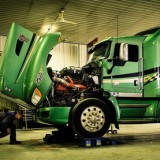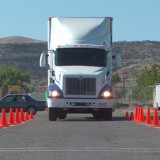Summer Trucking Preparations
While it is common knowledge that trucks must be prepared for cold weather and poor conditions, it is equally important that trucks be prepared for the heat of summer. High temperatures can put strain on the mechanical components, and hot asphalt can increase the risks of blowouts and tire damage. To prevent mechanical failures and costly repairs, it is important to properly prepare trucks prior to summer usage. Summer Trucking Maintenance Preparations To ensure that the tires are safe for use in hot conditions, the tire pressure should be checked when temperatures begin to rise, and on a regular basis throughout the summer. Tires typically lose about one psi per month, but may lose more when temperatures shift dramatically. Underinflated tires have a higher chance of catastrophic blowouts, especially if the outside temperature exceeds 90 degrees. Underinflated and overinflated tires also decrease fuel efficiency and wear out faster. Mechanical Systems Prior to operating a truck during the summer, it is important that all fluids be topped off and all systems receive proper maintenance. Belts should be checked and replaced as needed, and any recommended maintenance based on mileage should be completed. Air conditioning should be inspected prior to the season to ensure functionality, as a failed air conditioning unit can pose health risks for the driver. Refrigerated Trucks High temperatures put additional strain on refrigeration units, so it is imperative to test cooled compartments regularly and perform maintenance as needed. Refrigeration failures during the heat of summer can be costly for trucking companies, both in terms of repairs and damaged shipments. Refrigeration failures can also impact customer relations when deliveries fail to be delivered on time and in good condition. Summer Trucking Cleaning Preparations Removing leftover residues from winter sand and salt can help to improve the efficiency of vehicles and prevent costly corrosion repairs down the road. When cleaning trucks in preparation for the summer, it is important to ensure that hidden places on the truck are cleaned as well as the outside. The radiator, undercarriage, and other hard to reach areas may harbor sand and chemical build-ups that can damage systems. Driver Summer Preparations Truck drivers should also be sure to properly prepare for summer by staying hydrated and taking precautions. Drivers that are exposed to the sun for long periods of time when making deliveries should wear protective clothing and sunscreen. Drivers should also be sure to rest in cooled areas when necessary to prevent against heat stroke. Truck drivers that are operating while overheated or dehydrated not only put themselves and the delivery in danger, but also pose a risk to other drivers. Sources: http://www.consumerreports.org/cro/news/2012/08/tips-to-keep-your-car-tires-cool-amid-damaging-summer-heat/index.htm http://www.dmvflorida.org/tires-heat.shtml...
read moreCommercial Driver License
Under federal law, a commercial driver license (CDL) is required for those who wish to operate vehicles weighing 26,000 pounds or more for commercial use. Other requirements for a commercial driver license include transportation of hazardous materials regulated by the Department of Transportation, as well as vehicles designed for 16 or more passengers. These requirements went into effect under the Commercial Motor Vehicle Safety Act of 1986. Commercial Driver License Skills Those who drive commercial vehicles must have a higher level of experience, knowledge, physical abilities, and skills than those who drive non-commercial vehicles. Due to the inherently dangerous and challenging nature of driving a commercial vehicle, these drivers are held to higher standards. If drivers commit serious traffic violations, their commercial driver license eligibility may be affected. Applicants must pass knowledge and skills testing in order to receive a commercial driver license. Licensing by State The process and requirements for obtaining a commercial driver license will typically vary by state. The Federal Motor Carrier Safety Administration’s (FMCSA) CDL Division oversees this process across states and sets standards that apply to commercial drivers. The FMCSA CDL Division is responsible for the creation and maintenance of special policies, guidelines, and procedures that create a foundation for each state’s program. While each state’s specific regulations may vary, they must all comply with the federal standards expected of each state. Commercial Driver License Testing Federal laws state that in order to obtain a commercial driver license, each applicant must pass a written test detailing highway safety. Additionally, applicants must pass a test about the different parts featured on a commercial vehicle. This test is required to feature a minimum of 30 questions. A passing score equates to roughly 80 percent correct answers. Driving Skills Test Each applicant must also pass a driving skills test. During the driving skills test, the applicant must drive the type of vehicle that he or she expects to operate after obtaining the commercial driver license. The driving skills test requires that applicants perform a certain set of maneuvers in the vehicle. When the driver wishes to obtain certain endorsements, such as Air Brakes, he or she must operate a vehicle that features the proper equipment. Commercial Driver License Features Information featured on a CDL includes, but is not limited to, the following: The driver’s full name, mailing address, and signature Physical identification information, such as date of birth, height, and sex A colored photograph of the driver The issuing state and state license number of the driver The group(s) of vehicles that the driver has received authorization to drive, such as combination vehicles, double/triple trailers, hazardous materials vehicles, or school...
read moreWoman Killed in I-4 Dump Truck Accident
A fatal dump truck accident killed a DeLand woman on Monday, April 28, 2014. The accident occurred shortly before 7 a.m. east of the St. John’s River Bridge on Interstate-4 (I-4). Other victims sustained minor injuries from the accident. Seconds before the accident occurred, the tread of the front left tire of the dump truck separated from the tire’s frame. This caused the dump truck to lose control and run off of the eastbound I-4 lane on which it was traveling. The truck ran through the guardrails separating the eastbound and westbound I-4 lanes and crashed into three westbound vehicles. Highway Accident Death The Florida Highway Patrol identified the victim as 32-year-old Logan Cool. Reports state that Cool was on her way to work when her black 2004 Honda sedan was stuck, killing her on the scene. The FHP reported that the dump truck first sideswiped a pickup truck, and a white sedan hit the guardrail after attempting to swerve out of the dump truck’s way. The truck struck the left side of Cool’s Honda, a collision which the FHP described as unavoidable. Minor Injuries The 51-year-old dump truck driver, Franklin Ramirez, was treated for minor injuries at Orange City’s Florida Hospital Fish Memorial. Fifty-seven-year-old Guillermo Rodriguez of Palm Coast, along with two other adults and a child, were treated for minor injuries at Central Florida Regional Hospital. A pickup driver named Michael Greeno, age 34, was also involved in the accident. However, Greeno was uninjured. Traffic Impact For a time, both the eastbound and westbound lanes of I-4 were closed. Due to the crash occurring in westbound lanes, westbound I-4 was closed for roughly four hours after the accident. The FHP also used this time to clean up roughly 60 gallons of fuel that spilled from the truck and onto the interstate. While the lanes were closed, hundreds of motorists were re-directed to side roads near the interstate. Side roads such as U.S. 17-92, State Road 415, and Dirksen Road were flooded with commuters attempting to travel between Orlando and West Volusia cities. Many of these commuters became stranded in hours of standstill traffic. Tread Separation The Florida Highway Patrol, as well as witnesses from the scene, have confirmed that tread separation was the cause of the dump truck’s loss of control. There does not appear to have been a “blowout” of the tire. The FHP is continuing its investigation of the accident and the truck to determine the nature of the tread separation and the exact cause of the...
read moreNew Hours of Service Laws Spark Controversy
A federal trucking regulation that limits a trucker’s hours on the road took full effect in July 2013. This trucking rule, called Hours of Service, was mandated by the U.S. Department of Transportation’s Federal Motor Carrier Safety Administration (FMCSA). The new law is aimed at reducing trucker fatigue and increasing overall safety on the road for truckers and other drivers. However, the regulation is sparking controversy from opponents who argue that truckers, consumers, and small business owners are negatively affected. Hours of Service Rule The main component of the Hours of Service rule states that truck drivers are limited to a 70-hour work week. This figure has been reduced 12 hours from the outdated 82-hour maximum. In turn, it is expected that drivers will be more rested, and therefore road safety from fatigued drivers will improve. The FMCSA notes that the Hours of Service rule will only impact the most extreme schedules. An estimated 85 percent of truck drivers will remain unaffected. Other components of the Hours of Service rule state that: Drivers who reach the 70-hour limit may resume driving under the condition that they receive 34 hours of consecutive rest, including a minimum of two nights when the body’s clock most demands sleep: 1 a.m. to 5 a.m. Drivers must take a 30-minute break within a shift’s first eight-hour period Trucking Law Controversy Critics of the new Hours of Service regulations argue that the trucking industry will suffer a yearly loss of roughly $376 million, which will affect drivers, businesses, and other parties who depend heavily on the industry. The American Trucking Association has filed a lawsuit against the FMCSA in an attempt to halt the regulations. In addition to the limitations on hours, truckers and trucking companies face large fines when the rule is violated. Each time a driver violates the new regulations, he or she may face up to $2,750 in civil fines. The company allowing the driver to do so may face fines of up to $11,000. Trucking Law Projected Benefits The FMCSA asserts that the Hours of Service rule will have a number of benefits for the public. Long hours are often associated with a lack of adequate sleep. In turn, a lack of sleep is associated with chronic fatigue and an increased risk of crashes. Sleep deficit may also cause several chronic health conditions in drivers, including high blood pressure, obesity, sleep apnea, and diabetes. The FMCSA projects that the new regulations will save 19 lives each year. Additionally, an estimated 560 injuries and 1,400 crashes are expected to be...
read moreWinter Trucking Safety
Winter can present special dangers for truck drivers across the United States. Winter trucking safety is especially important for northern truck drivers, as ice and snow can create dangerous driving conditions. Icy, slippery roads can be disastrous for trucks carrying thousands of pounds of cargo. Winter trucking safety involves caution while driving. Driving slowly and obeying all traffic laws can play a key role in preventing winter trucking accidents. Winter Trucking Safety Preparation One of the most important winter trucking safety tips is to be prepared. Truck drivers should leave early and always know their destination and which routes they plan to take. As an extra precaution, drivers should map out potential routes in case they may need to exit off of the highway. Indecisive driving may contribute to trucking accidents. Emergency Kit Winter trucking safety precautions should also involve having an emergency kit on hand. An emergency kit should contain items that drivers may need in the event of several types of road emergencies. Supplies should include items for first aid, vehicle repair, driver safety and well-being, and nourishment in the event that a driver becomes stranded. An emergency kit should include: Battery-powered radio Flashlight Extra batteries Jumper cables Fire extinguisher Blanket First aid kit Flares Tire repair kit Bottled water Non-perishable food items Avoiding Road Hazards Drivers should check weather conditions in advance. If conditions are dangerous, drivers should consider delaying their trip for more favorable conditions. Conditions such as ice, hail, and snow are particularly dangerous. In these cases, the best winter trucking safety precaution is to avoid driving all together if possible. Drivers should also try to limit driving to during the daylight when traveling through harsh conditions. Checking for Black Ice Black ice is a term referring to a thin layer of transparent ice that develops when temperatures are near freezing. Black ice earns its name from its appearance. Its transparency often makes the ice difficult to tell apart from the black color of the road. When visible, black ice often appears as though the road is wet. Black Ice Warning Signs Drivers should check their truck’s mirror arms, top windshield corners, and antenna for ice build-up. These signs often indicate the possible formation of black ice on the roads. Additionally, drivers can predict black ice by paying attention to the spray from the tires of the vehicle in front of them. If the spray eventually stops, the water on the roads may have...
read more


















